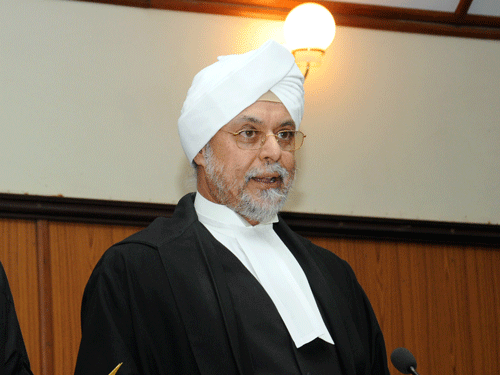The Government refuses to treat me at par with my fellow employees serving under the government or incidentally discriminates with me monetary or otherwise; my tenant refuses to vacate my house or someone refuses to honour his promise. With the amount of economic activity conducted in India all such disputes have become a part and parcel of everyday life. A robust judiciary is not only needed for safeguarding commercial interests but also for fulfilling certain constitutional obligations set upon the State, whether the negative ones in the form of Fundamental Rights or those requiring overt actions on the part of the State agencies in the form of the Directive Principles for State Policy.
Indeed, a judicial system where the aggrieved has to even think twice before approaching the Courts due to sluggishness in the system is one of the biggest impediments in the uninterrupted growth of any Nation but sadly it is the reality of our Nation. The disputants more often than not end up compromising with injustice because they feel that the costs of approaching the Court may by far exceed its benefits. Though no one can even doubt the wisdom of the Indian judges but the inability of the system as a whole to handle the ever increasing burden is a sad reality. In such a background, Justice JS Kehar is bound to take up the highest judicial office on 4th January next year
Here we look at some statistics which account for the inexorable delays in Court trials, the challenges before the next CJI to be appointed soon, the need for alternative dispute resolution mechanisms and the need for a system of minimum terms for those who head the top judicial post.
Paucity of Judges:
As reiterated by the Chief Justice of India T.S. Thakur recently, the 1987 Law Commission had recommended a ratio of 50 Judges per million as compared to the then ratio of 10 Judges for per 10 lakh people for effective administration of justice. Unfortunately, things have not moved as quickly as they should have since then and currently the situation is that on an average 18 Judges are handling 10 lakh people.
The situation is far worse in populous States with high crime rates such as Uttar Pradesh and West Bengal where the Judge to population ratio is a flummoxing figure of roughly 11 Judges per million people. The issue of paucity of judges has been an eternal problem in the Indian context but the current situation is even more precarious with a deficit of 477 Judges in the 24 High Courts of the country itself. Paucity of Judges is the cardinal culprit behind the huge arrears and the saga of never ending litigation between the ordinary citizens which makes the process of remedy for the wrong a wrong itself.
Paucity of judges is not the only issue that needs to be addressed another culprit behind the huge arrears of the Courts is the cumbersome procedures that the legislature has enacted. While certain minimum procedural requirements are prerequisites of a judicial system in any civilized society, India’s case is one where extensive procedures have made it a lawyer’s paradise and has lent sustainability to a section of advocates who find it convenient to drag on the disputes of their contestants for their personal gain.
Challenges before the next CJI:
Supreme Court Judge Justice JS Kehar will be sworn in as the 44th Chief Justice of India on 4th January next year. He takes up the top post at a time when the Judiciary-Executive relations have already taken a downturn with several confrontations ever since the current dispensation came to power. It started with the apex court rejecting the National Judicial Appointments Commission Law which sought to replace the existing collegiums system passed by the Parliament with overwhelming majority as ultra vires the Constitution of India and terming it a threat to judicial independence. This was followed by the Supreme Court setting aside the proclamation of President’s rule in the states of Arunachal Pradesh and Uttarakahand.
The Indian judiciary has gone through a horrid time in the 1970s when the Indira led Government involved itself in a period of acrimonious relationship with the higher judiciary and did not leave a stone unturned to tame the authority of the Judges and deny them the independence that must be given to them for effective administration of justice.
The onus would be on the successor of Justice Thakur and the Centre to make sure that the executive and the judiciary is on the same page to work out a way in which the Courts can handle their arrears and the confidence of the citizen is restored in the judicial system.
Another pertinent challenge that he faces is the fact that he will have roughly a meager 6 months to deal with and somehow improve the precarious system. This is an issue that almost every Supreme Court Judge appointed as CJI is bound to face under the current scenario and is dealt subsequently in this Article.
Minimum tenure for CJI:
A Parliamentary Committee rightly pointed out in its report submitted last Thursday that in the last 20 years 17 Chief Justices have taken control of the affairs and many of them did not get to serve for more than one year. It is true in the recent context also with the current Chief Justice of India holding the position for less than six months and his predecessor also set to retire within a similar time frame. Similarly, in the case of the High Courts also most of the Chief Justices remain at the helm of affairs for less than two years. This is the biggest impediment in way of anyone holding the prestigious post to take any medium to long term steps in order to alleviate the ailing system. In such a background, it is the need of the hour that every Chief Justice is given a minimum term at the time of appointment itself so that a proper course of action can be taken up.
Conclusion:
The inexorable delays in the Indian judicial system is an intricate issue which requires a multi-pronged solution. Apart from increasing the total strength of judges and finding the ideal system of appointment of judges to the higher courts, the academicia, the Government and the administrators in the judicial system must get together in order to promote an effective solution, ADR mechanisms. Even though the judiciary and the executive have taken several steps in the past to incorporate Alternate Dispute Resolution mechanisms in the past ranging from enactment of statutory provisions empowering Courts to direct parties to resort to ADR mechanisms in case there is an element of settlement to the establishment of Lok Adalats, it seems that a lot lefts to be done to make it an intrinsic part of dispute resolution in the Indian context. Once, the disputants are somehow accustomed to resort to such mechanisms significant burden would be taken off the Courts and petty disputes would be taken care of at the nascent stage itself allowing the judiciary to decide the more serious matters which necessarily require judicial intervention.
































